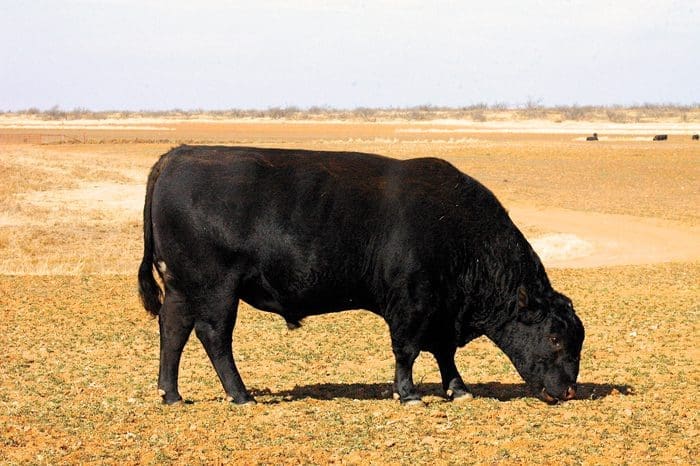Good Genetics, Price and Even Weather Risk Management
By Larry Stalcup, Contributing Editor
“There is not accountability until a crisis occurs.”
When he’s discussing ranch management, Stan Bevers usually gets to the point. And if you’re not prepared for the worst, those tight margins may strangle any chance for a profit. Bevers, former Texas A&M University ag economist and now a King Ranch Institute for Ranch Management analyst, said producers have access to tools to manage their production and offset poor performance.
He was part of the late-summer Cattlemen’s College during the Cattle Industry Convention in Nashville. His reference to “crisis” can include everything from drought to a poor-quality calf crop. Sessions by the University of Missouri’s Jared Decker, who promoted using the best genome technologies to identify the best replacement heifers and bulls, and Virginia Tech University’s Vitor Mercadante, who discussed the need to improve reproductive efficiency, addressed the breeding end of “crisis” management.
Breed DNA Testing
Breed associations offer commercial and seedstock producers access to data from advanced sire and dam DNA testing. Decker, a reproduction specialist, put replacement selection bluntly.
“Until a heifer is pregnant within a desired breeding season [usually in the first one to 21 days], she is a candidate, not a replacement,” he said. “So it’s important to test many more heifers than you plan to keep.”
If testing a registered animal, Decker advises producers use the breed association’s genomic prediction to produce genetically enhanced expected progeny differences (GE-EPDs).
“If testing commercial straightbred cattle, use a breed-specific test if it’s available,” he said. “A breed-specific test is going to outperform multiple-breed tests.”
Decker emphasized that bulls need to have GE-EPDs. “DNA testing reduces the chance of making that unlucky decision [when buying breeding stock],” he said. “Breed associations are concerned with how the testing information gets adapted by the industry.”
ID Better Females Early
Mercadante, Virginia Tech animal science professor, agrees that early breeding is important for a heifer or cow that generates income. He cites several requirements for best-performing females:
- A heifer must calve by 24 months of age.
- A cow must calve every 365 days.
- She must calve without assistance.
- She must be genetically capable to perform.
- She must provide sufficient resources for the calf to reach its genetic potential.
- She must maintain her body condition score for management conditions.
Temperament impacts fertility, Mercadante said, pointing out that calmer females breed at a higher rate than excitable females. He encouraged producers to use proven DNA testing as well as effective ranch management to get better breeding and calving rates.
“Good heifer record keeping is needed to improve breeding performance,” he said. “Partnerships with personal veterinarians, Extension specialists and others can help producers improve management performance.”
Confront External Forces
Bevers contended that ranchers need to determine the “three Ps – position, performance and projections” when devising a ranch management plan.
“We need to be proactive in determining how to minimize the threat of an external force,” he said. “Ranch financials and livestock inventory need to be managed closely.”
Bevers said the overall ranch “position” serves as a baseline for livestock, inventory, natural resources and financials. He added that “performance” in production, financial and resource management should be measured for the past year,” he said.
“And ask yourself, Do the ranch ‘projections’ show positive movement toward the ranch mission statement and vision for the next three years?”
Measuring the three Ps calls for sound communication between ranch family members and the ranch manager and possibly other employees.
“Communication between ranch generations is essential,” Bevers said. “Consider different scenarios. Plan for things that may come. What if the general manager wants more money and you’re not where you want the ranch to be? What if you need to cut the herd by 25 to 30 percent?”
Price risk management should be considered through forward prices for calves, using U.S. Department of Agriculture Risk Management Agency (RMA) programs, or price protection through futures or options. Drought insurance has become a valuable tool offered by RMA. And with drought always just another dry spell away, future “weather-management” considerations could provide finances for buying replacements for part of herd liquidation needs, Bevers said.
He stated that producers should “be able to reconcile your inventories” to help maximize productivity. Decker added that investments into GE-EPDs should come with marketing for a premium.
“If you use DNA testing, make sure you’re getting paid a premium for your calves,” he said. “It’s time as an industry to get on board and use genomic tools. The possibilities for improvements are much better. Operations that don’t use these tools will no longer be viable and sustainable.”
And if a calf crop misses the mark for a $10 to $15/cwt. premium, the bottom line takes a big hit. In other words, there is not accountability until a crisis occurs.







